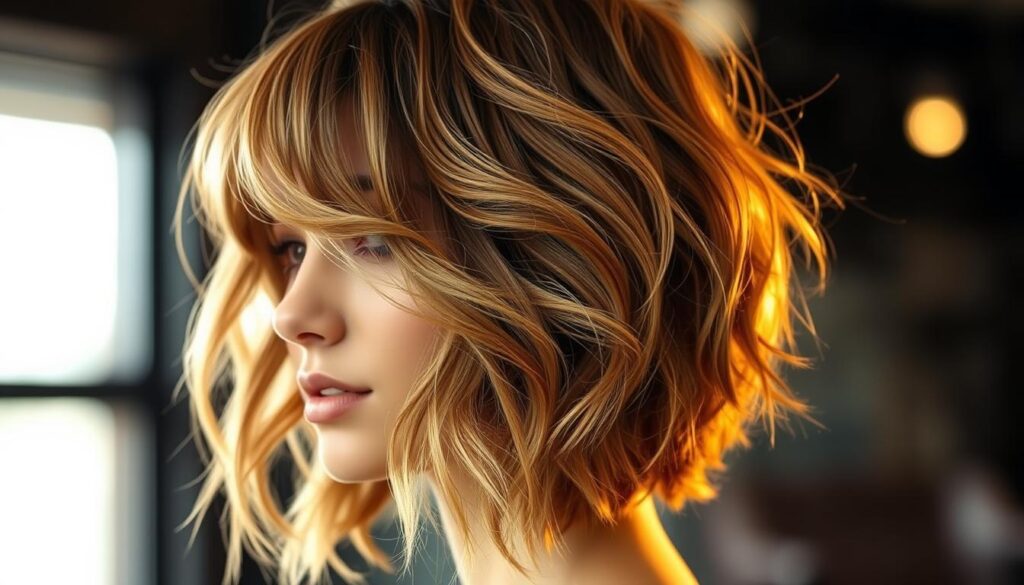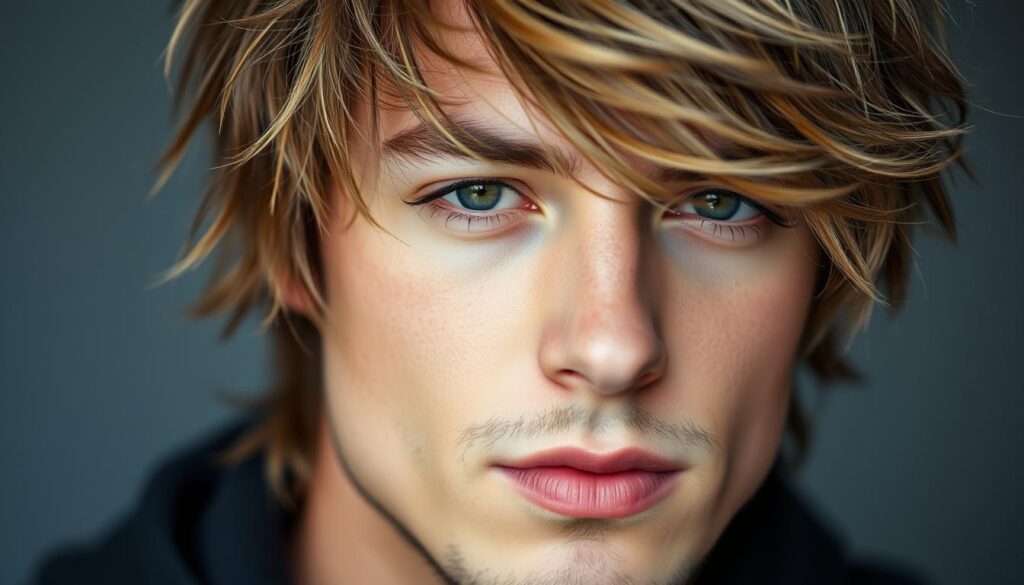
What if your hair could look effortlessly stylish without hours of daily maintenance? The answer lies in a retro-inspired hairstyle that’s dominating modern barber shops. Originally popularized decades ago, this layered look blends messy texture with intentional shape – perfect for guys craving a relaxed-but-polished appearance.
This versatile style thrives on natural movement, whether your hair is straight, wavy, or somewhere in between. Its secret? Strategic layers that add volume to fine strands and soften thick textures. Unlike high-maintenance cuts, it grows out gracefully, keeping you salon-ready for weeks.
The modern update retains the cool vibe of its vintage roots while adapting to today’s grooming standards. Celebrities and influencers have embraced its ability to frame face shapes from oval to square. Best of all, you can achieve that “just rolled out of bed” charm with minimal product – a quick tousle does the trick.
Key Takeaways
- Works with all hair types, including straight, wavy, and fine textures
- Requires less daily styling than most contemporary cuts
- Enhances facial features through customizable layering
- Blends 1970s rockstar energy with modern sophistication
- Ideal for achieving a confident, laid-back appearance
Understanding the Shag: A Modern Twist on a Classic Cut

Rock stars of the ’70s didn’t just create music—they sparked a hair revolution that still influences today’s styles. This layered look emerged as a badge of rebellion, challenging rigid grooming norms with its artfully disheveled layers. Icons like Mick Jagger and David Bowie turned heads with their tousled crowns, blending rockstar edge with unexpected sophistication.
History and Retro Influences
The original style mirrored its era’s free-spirited energy. Barbers used razor-cutting techniques to create feathery layers that moved with every guitar riff. “It wasn’t just a haircut—it was a manifesto,” notes a vintage barbering manual. This approach softened angular jawlines and gave thinner hair dramatic volume, making it a favorite among performers and creatives.
| Era | Key Features | Cultural Impact |
|---|---|---|
| 1970s | Razor-cut layers, extreme texture | Symbol of counterculture |
| Today | Softer graduation, face-framing | Balances edge with polish |
Evolving Trends in Men’s Haircuts
Contemporary versions use precision scissors-over-comb techniques for cleaner lines. Stylists now tailor the shape to individual face structures—shorter layers for round faces, longer pieces for oblong shapes. Matte pastes replace the greasy gels of yesteryear, offering flexible hold without stiffness. This evolution makes the style work in both casual and professional settings.
Shag Cut Men: Defining the Signature Look

The secret to this style’s enduring appeal lies in its architectural approach to hair design. Unlike uniform trims, it combines varied lengths that cascade like stair steps from crown to ends. This creates dimension that catches light differently as you move, giving hair a lived-in dynamism.
What Sets This Cut Apart?
At its core, the technique removes bulk while preserving bounce. Stylists carve shorter pieces around the parietal ridge—the area above your ears—to lift roots. These gradually blend into longer layers that graze collarbones or jawlines, depending on your preference.
Feathered ends are non-negotiable. They prevent harsh lines, letting strands fall in soft, piece-y angles. This asymmetry works with your natural texture, whether you’re scrunching waves or finger-combing straight locks. The result? Hair that looks intentionally undone, never sloppy.
Versatility is baked into the blueprint. Round faces benefit from vertical layers that elongate features, while square jawlines soften with side-swept fringe. It’s why everyone from surfers to CEOs can rock this look—it adapts to your lifestyle, not the other way around.
Exploring Variations for Different Hair Textures
Your hair’s natural texture becomes the blueprint for crafting your ideal layered style. Barbers strategically adjust their approach to enhance what you’ve got—whether you’re working with pin-straight strands or dense coils. This customization ensures your look complements your hair’s unique behavior rather than fighting against it.
Styles for Straight, Wavy, and Thin Hair
Fine or straight hair gains instant dimension with staggered layers. These create optical volume at the roots while maintaining weight at the ends. Natural waves get amplified through curved cutting techniques that follow your hair’s bend pattern. “We use point-cutting to encourage piece-y separation,” explains NYC stylist Marco Rivera. “It lets waves clump naturally without looking over-styled.”
Adaptations for Curly, Coily, and Thick Hair
Dense textures benefit from deep layering that removes bulk while preserving shape. Curly hair types see enhanced definition when longer layers frame the face. Coarser strands require texturizing shears to soften edges without sacrificing movement. The key lies in balancing structure with your hair’s innate springiness.
| Hair Type | Technique | Result |
|---|---|---|
| Straight/Thin | Feathered layers | Adds lift at crown |
| Wavy | Diagonal slicing | Enhances wave pattern |
| Curly/Coily | Dry cutting | Defines curl clusters |
| Thick | Underlayer removal | Reduces weight |
Thick hair gets transformed through strategic underlayer trimming. This maintains surface density while allowing easier styling. For those with tighter curls, stylists often cut dry to see how each ringlet behaves. The goal? A shape that looks great whether you air-dry or diffuse.
Styling Techniques for Effortless Texture and Volume
Mastering your layered hairstyle starts with smart product choices and drying methods. The right approach enhances your hair’s natural personality while keeping that “woke up like this” charm. Let’s break down the tools and tricks professionals use to create lived-in texture.
Using Texturizing Sprays and Creams
Begin with damp hair—about 70% dry—to maximize product absorption. A light mist of sea salt spray adds grit and lift at the roots. “Texturizing sprays create instant separation between layers,” notes stylist Kristen Shaw. “They’re like hair perfume—subtle but transformative.”
For defined waves, work a nickel-sized amount of styling cream through mid-lengths. These creams tame frizz without flattening your hair’s natural bend. Avoid heavy gels or waxes—they weigh down delicate layers.
Blow Dry and Air Dry Methods for Natural Movement
Air drying works best for loose waves. Scrunch hair upward every 10 minutes as it dries to encourage bounce. Flip your head upside down periodically to prevent flat spots at the crown.
Need more volume? Use a diffuser on low heat. Cup sections of hair in the attachment while gently lifting roots. This method amplifies texture while maintaining softness.
| Method | Tools Needed | Best For | Result |
|---|---|---|---|
| Air Dry | Sea salt spray, wide-tooth comb | Casual, beachy looks | Organic separation |
| Blow Dry | Diffuser, heat protectant | Defined volume | Controlled movement |
Finger-styling beats brushes for this look. Rake your hands through strands to accentuate layers. Finish with a cold shot from your dryer to lock in shape without stiffness.
Essential Hair Products for Perfect Shag Haircuts
Your styling arsenal needs these game-changing products to unlock that perfectly undone texture. The right formulas enhance your hair’s natural personality while keeping maintenance minimal. Think of them as tools to amplify your layers’ built-in movement.
Light Wax, Matte Pomade, and Volumizing Mousse
Lightweight wax separates strands without stiffness—ideal for {{the}}, piece-y styles. Apply a pea-sized amount to damp hair, focusing on mid-lengths. It creates definition that lasts all day.
Matte pomade offers flexible hold for longer layers. Unlike glossy products, it maintains a natural finish. “Rub it between your palms first to warm up the formula,” suggests barber Luis Torres. “This prevents clumping and ensures even distribution.”
Volumizing mousse lifts roots for fine or straight textures. Spray it directly at your crown before blow-drying. The result? Body that stays put without crunchiness.
| Hair Type | Key Products | Benefits |
|---|---|---|
| Curly/Coily | Curl cream + diffuser spray | Defines ringlets, reduces frizz |
| Thick/Straight | Dry shampoo + texturizing spray | Adds grip, absorbs oil |
| Wavy | Sea salt spray + leave-in conditioner | Enhances bend, prevents dryness |
For your overall look, layer products strategically. Start with mousse at roots, then work wax through ends. Finish with a mist of texturizing spray for that sun-kissed, lived-in feel.
Retro to Modern: Shaggy Trends Inspired by Icons
The collision of past and present defines today’s most dynamic looks. Legendary rockers and modern A-listers have reshaped this layered style into something that feels both nostalgic and fresh. Let’s explore how vintage roots meet current innovations.
70s Shag Inspiration
Bowie’s lightning-bolt hair and Jagger’s untamed layers became symbols of self-expression. The original style featured feathered ends that danced with movement, creating volume even on flat textures. Barbers used razor techniques to craft those signature piece-y layers—a stark contrast to the polished looks of earlier decades.
Contemporary Adaptations for a Bold Look
Today’s versions balance rebellion with wearability. The shaggy mullet combines short, textured fronts with cascading back layers—seen on Dev Patel’s red-carpet appearances. Brad Pitt’s tousled fringe and Kit Harington’s face-framing pieces prove this style works in professional settings too.
| Era | Key Features | Style Icons |
|---|---|---|
| 1970s | Razor-cut layers, extreme volume | David Bowie, Mick Jagger |
| 2020s | Softer graduation, hybrid shapes | Dev Patel, Timothée Chalamet |
Modern barbers use scissor-over-comb methods for cleaner lines. They might keep lengths longer around the ears to soften square jaws or add wispy bangs for oval faces. Matte clays replace old-school gels, offering flexible hold without shine.
Choosing between vintage and contemporary? Consider your daily routine. Retro styles demand more frequent trims, while updated versions grow out seamlessly. Either way, you’re channeling a legacy of confidence—just with less effort.
Maintaining Your Look: Care Tips and Routine
Your hairstyle’s longevity depends on smart upkeep strategies. Unlike traditional trims, modern maintenance focuses on preserving texture while managing bulk. Let’s explore how to keep those layers looking fresh without losing their signature movement.
Trimming Techniques and Micro-Trims
Professional stylist Kristen Shaw emphasizes “horseshoe” micro-trims for crown maintenance. This method removes weight from the upper back of your head, letting longer layers lie flat naturally. Schedule these touch-ups every 6-8 weeks to prevent split ends without sacrificing length.
| Maintenance Type | Frequency | Purpose |
|---|---|---|
| Neckline Cleanup | Every 3-4 weeks | Sharpens edges |
| Crown Micro-Trim | Every 6-8 weeks | Controls volume |
| Full Shape-Up | Every 12 weeks | Resets layers |
Damp Hair Care and Product Application
Start with cool water rinses to seal hair cuticles before styling. Apply products to damp strands for even distribution:
- Blot hair with microfiber towel (don’t rub)
- Work texturizing spray through mid-lengths
- Scrunch roots upward for lift
For air dry enthusiasts, flip hair side-to-side every 15 minutes to prevent flat spots. Those with thicker textures might add mousse before drying to enhance separation. Remember: over-washing strips natural oils that give shaggy hairstyles their lived-in appeal.
Complementing Your Shag with Facial Hair and Style Choices
Your hairstyle becomes a complete style statement when paired with intentional facial grooming. The right beard or stubble balances your textured layers, creating visual harmony that sharpens your overall appearance. This combination works like natural contouring, drawing attention to your best features while softening stronger angles.
Integrating Facial Hair for a Cohesive Look
Light stubble adds rugged contrast to shaggy hairstyles without overwhelming your face. For square jawlines, keep beard lines slightly rounded to complement your hair’s movement. Full beards work wonders for oval faces, adding width where needed.
Maintain facial hair at a length that mirrors your hair’s texture. Wispy layers pair well with trimmed beards, while denser curls can handle bushier styles. Use a quality trimmer every 3 days to keep edges crisp but not overly sharp.
Color coordination matters. Dark beards against lighter hair create striking definition, while matching tones offer subtle sophistication. Always blend your sideburns seamlessly into longer layers—this prevents abrupt transitions that disrupt your effortless vibe.
Remember: facial hair shouldn’t compete with your haircut. Let your textured crown take center stage by keeping beards neatly shaped. This approach frames your face while letting your personality shine through.
